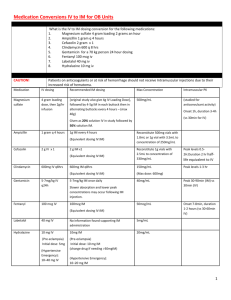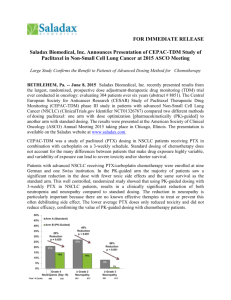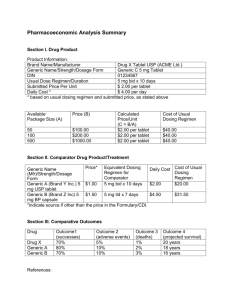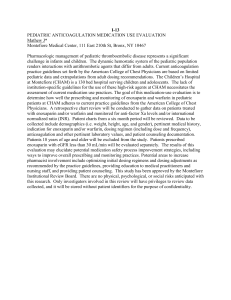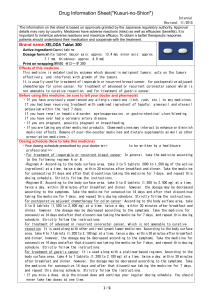SUPPLEMENTARY METHODS & RESULTS SUPPLEMENTARY
advertisement
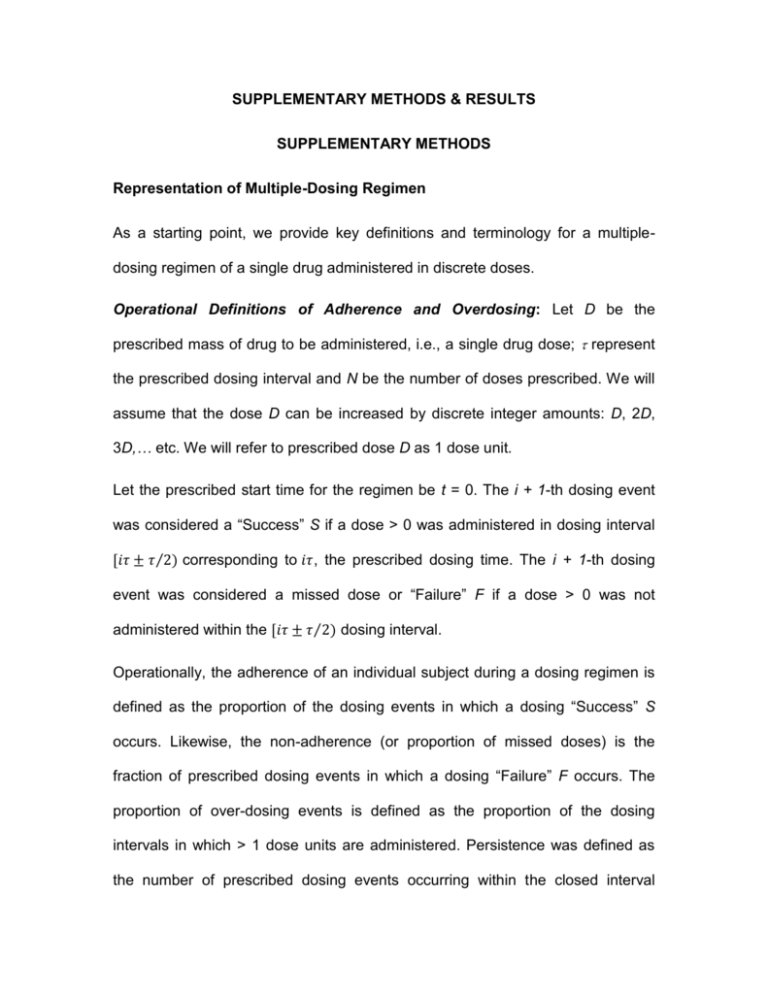
SUPPLEMENTARY METHODS & RESULTS
SUPPLEMENTARY METHODS
Representation of Multiple-Dosing Regimen
As a starting point, we provide key definitions and terminology for a multipledosing regimen of a single drug administered in discrete doses.
Operational Definitions of Adherence and Overdosing: Let D be the
prescribed mass of drug to be administered, i.e., a single drug dose; represent
the prescribed dosing interval and N be the number of doses prescribed. We will
assume that the dose D can be increased by discrete integer amounts: D, 2D,
3D,… etc. We will refer to prescribed dose D as 1 dose unit.
Let the prescribed start time for the regimen be t = 0. The i + 1-th dosing event
was considered a “Success” S if a dose > 0 was administered in dosing interval
[𝑖𝜏 ± 𝜏⁄2) corresponding to 𝑖𝜏, the prescribed dosing time. The i + 1-th dosing
event was considered a missed dose or “Failure” F if a dose > 0 was not
administered within the [𝑖𝜏 ± 𝜏⁄2) dosing interval.
Operationally, the adherence of an individual subject during a dosing regimen is
defined as the proportion of the dosing events in which a dosing “Success” S
occurs. Likewise, the non-adherence (or proportion of missed doses) is the
fraction of prescribed dosing events in which a dosing “Failure” F occurs. The
proportion of over-dosing events is defined as the proportion of the dosing
intervals in which > 1 dose units are administered. Persistence was defined as
the number of prescribed dosing events occurring within the closed interval
between the first observed dosing “Success” and last observed dosing
“Success”.
Reference Regimen: A patient who is completely adherent to the regimen will
administer a dose, D, of drug exactly at times t = 0, 1, 2, …, (N–1) This
ideal, gold-standard reference dosing regimen 𝕊 can be represented by the
ordered set of triples:
𝕊 = {(0, 𝐷, 0), (1, 𝐷, τ), … , (j, 𝐷, jτ), … (𝑁 − 1, 𝐷, (N − 1)τ) … }
We refer to j as the time index because it marks the time difference between the
jth dose and the first dose.
Direct Dosing Time Representation of Observed Dosing Regimen: In the
direct dosing representation framework, the actual drug-dosing regimen for a
patient can be represented in terms of the actual dose di (where di ≥ D) and the
corresponding time of administration ti. In this direct representation, the observed
dosing regimen 𝔻 can be analogously represented by the ordered set of triples:
𝔻 = {(0, 𝑑0 , 𝑡0 ), (1, 𝑑1 , 𝑡1 ), … , (𝑗, 𝑑𝑗−1 , 𝑡𝑗−1 ), … (𝑢 − 1, 𝑑𝑢−1 , 𝑡𝑢−1 ) … }
Note that t0 < t1 < t2 …< tn-1. In this representation, u represents the number of
dosing “Successes”; u ≤ N because the patient may not consume all the doses
prescribed. Further, the value of tu-1 may be greater than, equal to or less than
(N–1) depending on the adherence behavior.
Delta Representation: We can often re-write the observed dosing regimen 𝔻
without loss of generalization in a form useful for Markov chain modeling:
′
𝔻0 = {(0, 𝑑0′ , 𝛿0 ), (1, 𝑑1′ , τ + 𝛿1 ), … , (j, 𝑑𝑗′ , (j − 1)τ + 𝛿𝑗−1 ), … (𝑛 − 1, 𝑑𝑛–1
, (𝑛 − 1)τ +
𝛿𝑛−1 )}
where: 𝑑𝑗′ = 𝑑𝑗 , the corresponding dose from the direct dosing time
representation if the dose is taken and 𝑑𝑗′ = 0 if the dose is not taken. The 𝛿𝑗
represents the dose-timing deviations from the prescribed dosing times and 𝑛 is
the persistence.
This form enables the observed dosing regimen to be mapped to the reference
regimen. The value of the index j is calculated from the observed dosing times
using the 𝑅𝑜𝑢𝑛𝑑 function, which rounds decimal values ≥ 0.5 upward to the
nearest integer and decimal values < 0.5 downward to the nearest integer:
𝑡𝑗
𝑗 = 𝑅𝑜𝑢𝑛𝑑 [ ]
𝜏
The value of 𝑗𝜏 + 𝛿𝑗 is set equal to the dosing time to obtain 𝛿𝑗 , the dose-timing
deviation from the prescribed dosing time:
𝛿𝑗 = 𝑡𝑗 − 𝑗𝜏
For completeness, the values of 𝑑𝑗 and 𝛿𝑗 are set to a value of zero at the time
indices j at which a dose is not administered.
Non-Dimensional Representation: By normalizing the administered dose to the
prescribed dose, and by expressing the dosing time in angular coordinates (in
radians) on the dosing clock, a non-dimensional representation Φ can be
obtained:
Φ = {(0, 𝑑0 ⁄𝐷 , 2𝜋𝛿0 ⁄𝜏), (1, 𝑑1 ⁄𝐷 , 2π(1 + 𝛿1 ⁄𝜏 )), … , (j, 𝑑𝑗 ⁄𝐷 , 2π(𝑗 +
𝛿𝑗 ⁄𝜏)) , … (n − 1, 𝑑𝑛−1⁄𝐷 , 2π(𝑛 − 1 + 𝛿𝑛−1 ⁄𝜏))}
The angular representation underscores that almost all chronic dosing regimens
are periodic in nature and occur around the 24-hour clock – this will become
important when considering a suitable density function for modeling dosing
intervals. The angular representation enables circular statistics based on the von
Mises distribution to be leveraged.
Distribution of Dosing Runs
We extended the model by using the theory of runs to compute the distribution of
the dosing runs, which is critical to assessing the distributions of drug holidays
and dosing intervals. Exact formulas for run statistics require combinatorial
probability techniques 10,11 and are surprisingly complicated even for the simplest
case of independent, identically distributed Bernoulli random variables. However,
the use of the Markov chain imbedding technique, which was developed by Fu
and Koutras, has allowed a wide range of success run distributions to be derived
using intuitive methodology for identical and non-identically distributed, Markovdependent trials 12.
The first step in the method is to identify the state space that completely includes
all the m discrete outcomes possible at any dose event or trial. The second and
most critical step is to identify the transition matrix that describes the probability
of achieving any given outcome in the state space from any given state. The
subsequent steps are standard in the theory of Markov chains, i.e., the
distribution of all outcomes is completely contained in the product of two
matrices: i) an initial condition matrix, and, ii) a matrix product of the transition
matrices at each dose event. The system is allowed to evolve from a single
initial state containing no runs. We refer the interested reader to Fu and Koutras
12
for theoretical aspects and to Koutras and Alexandrou
13
for the computational
aspects of the procedure.
There are several ways of defining runs of length r in n dosing periods. For this
paper, we will focus exclusively on 𝐸𝑛,𝑟 and 𝐺𝑛,𝑟 .
1. 𝐸𝑛,𝑟 is the probability of a run of exactly r successes in n trials
example,
in
the
n
=
25
dose-event
27.
For
pattern
FSSSSFFSSFFSSSSSSFSSSSFFF there are 2 success runs with exact
length r = 4. These occur at trials 5 and 22 and are underlined.
2. 𝐺𝑛,𝑟 is the probability of a run of r or more successes in n trials. In the n = 25
dose-event pattern FSSSSFFSSFFSSSSSSFSSSSFFF there are 3 success
runs with length r ≥4 occurring at trials 5, 17 and 22 and they are underlined.
𝐺𝑛,𝑟 is the basis for drug holiday calculations. The computationally efficient
triangular matrix decomposition method
13
for calculating 𝐺𝑛,𝑟 was implemented
in Mathematica (Wolfram Research, Champaign, IL) on a MacBook computer
(Apple Computer, Cupertino, CA).
The exact distribution of runs (e.g., for Figure 1Q) was estimated using Monte
Carlo methodology implemented in the Mathematica (Wolfram Research,
Champaign, IL) software program. Each individual dosing regimen was simulated
100,000 times (10,000 for patient 808) to obtain the run counts and their
distribution. The predicted run distribution was compared to the observed run
distribution in patients using Fisher exact test in SPSS statistics software
(International Business Machines Corporation, Armonk, NY).
SUPPLEMENTARY RESULTS
Modeling Dose Timing Deviations with the von Mises Distribution
We assumed that the distribution of the dose-timing deviations, i.e., the
differences between the observed dosing time and the nearest prescribed dosing
time can be described using a von Mises distribution. Since the von Mises
distribution has not been previously used to model drug adherence, we provide
background on the salient characteristics of the von Mises density function
(Figures 3A-C). Figure 3A and 3B shows the effect of changing the mean µ of the
von Mises probability density function in Cartesian and cylindrical coordinates on
a unit circle. The von Mises density function qualitatively resembles the normal
distribution in that it exhibits symmetry about the mean parameter µ. However,
the effect of changing the mean parameter µ of the von Mises distribution is to
rotate the density function on the unit circle. Figure 3C shows the effect of
changing the parameter 𝜅 of the von Mises distribution with 𝜇 fixed at zero. The
value of 𝜅 is a measure of extent to which the data are concentrated around the
mean. Larger 𝜅 values result in sharper peaks with lower circular variance, and a
𝜅 value of zero represents a uniform distribution on the unit circle.
Supplementary Figure 1 Legend:
Probability-probability plots of expected probability from an exponential
distribution vs. the observed time interval between overdosing events (red
circles) for six representative patients (#808, #813, #820, #817, #802 and #834;
Patient #810 is not shown because there were only two overdosing intervals).
The blue line is the line of identity. The p-values shown are for a one-sample
Kolmogorov-Smirnov test against the exponential distribution.
